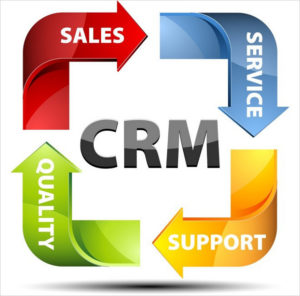by noah | Apr 10, 2018 | Uncategorized
 There are many types of databases, which can be categorized based on their functions and capabilities. Some databases are more popular than others. Let’s explore ten of the most common databases and the types of tasks they can be used for.
There are many types of databases, which can be categorized based on their functions and capabilities. Some databases are more popular than others. Let’s explore ten of the most common databases and the types of tasks they can be used for.
1. Relational Databases
Relational databases are most common and can be used across industries, including retail, medical, information technology and warehousing. In this database, information is stored in different data tables and connected to other tables. All the tables are related to each other using various key fields, hence the name relational. Some names you may know are Oracle, Microsoft Access and Microsoft SQL.
2. Operational Databases
Organizations work with large amounts of information, such as inventory, purchases, transactions and financials. In an operational database, all data is collected in a central location where it can be changed and manipulated according to the company needs. Also included are other databases that are needed to run the organization, including customer databases and inventory databases.
3. End-User Databases
The end users in an organization have access to some, but not all, information. These “workstations” act as small databases and can be accessed by the end user. Included in the database are spreadsheets, presentations, word files, downloaded files and notepads.
4. Distributed Databases
Many organizations are large and manage several different locations, regional offices, branch offices and manufacturing plants. To keep information organized and accessible, each department will have their own database that feeds into the main database. This is called a distributed database.
5. Analytical Databases
Analytical databases store information from various databases, such as pre-selected operational databases and external databases. The data stored in an analytical database is used for analytic purposes only. Unlike other databases, the information is read-only and cannot be changed or manipulated.
6. Real-Time Databases
Some things change so quickly, organizations would be analyzing outdated information if they didn’t have real-time databases. Real-time databases handle information that keeps changing and have the ability to update data every minute or less. Examples of industries that require real-time databases are banking, accounting and reservation systems.
7. Hypermedia Databases
A hypermedia database contains multimedia such as images, video clips and audio files. This data may need to be stored alongside information to expand on ideas or make sense of what’s there. In this database, users click on a link that brings them to interconnected multimedia pages.
Conclusion
Relational databases are most common and include some of the biggest names out there such as Microsoft Access and SQL Server. However, there are times when a basic relational database isn’t enough to store, manage and share information across an organization. If this happens, you’ll need to educate yourself on other database options or work with a database management company like Arkware to find the perfect solution.
by noah | Feb 7, 2018 | Uncategorized
 Are you considering adding a data management system to your business or organization? A data management system, or DBMS, is one way to organize your data. Many businesses start off using spreadsheets to manage information, but this can become tedious and cumbersome as your company grows. That’s not to say that you should get rid of a spreadsheet program like Excel completely, but taking advantage of a database system like Microsoft Access can help you be more efficient and successful.
Are you considering adding a data management system to your business or organization? A data management system, or DBMS, is one way to organize your data. Many businesses start off using spreadsheets to manage information, but this can become tedious and cumbersome as your company grows. That’s not to say that you should get rid of a spreadsheet program like Excel completely, but taking advantage of a database system like Microsoft Access can help you be more efficient and successful.
Let’s explore the benefits of using a DBMS to organize your company’s data.
Enhanced Data Security
Databases are more secure than spreadsheets, which is important considering that they usually contain sensitive information such as customer information, financial data, transactions and more. To make your Access database most secure, it’s recommended to encrypt your data. To do this, you’ll need to set a password. With Access 2016, the latest version available, encryption is improved for better protection.
Improved Data Sharing
What fun is data if you can’t share it with the rest of your team members? A data management system like Access lets you share data quickly and efficiently. There are a number of ways to share databases, so it’s important to do your research. For example, you can share data by using network folders, though this gives you the least options. On the other hand, you can share databases on a server, which offers the most functionalities. However, to do this, you will need a database server product.
Better Data Integration
It’s difficult to make data-driven decisions for your organization when you don’t have a complete picture of what’s going on. A DBMS provides an integrated picture of what’s taking place with your operations. With accurate, complete information at hand, you can make confident decisions. Of course, for the best integration, make sure you are using the proper management system and management tools.
Boosted Productivity
It’s understandable how productivity is increased when you have a DBMS keeping everything organized! Whether you need to generate reports, track inventory, review past invoices or simply make a quick decision, you can do so with a database management system. Plus, databases are reliable and regularly updated, so you can expect the most up to date information available.
Database management systems make businesses and organizations faster and better. It can be intimidating to move all of your data over to something like this, but rest assured that it will be worth it. To help, contact a database programming company like Arkware. We help businesses choose the best DBMS for their needs, whether it’s Access, MySQL or others. Call us today to learn more.
by noah | Jan 20, 2018 | Uncategorized
 Customer relationship management (CRM) is a way to manage all of your company’s relationships. The goal of CRM is to organize your interactions with customers to improve relationships. By keeping all of your communications in one central location, you can streamline processes, connect with new and prospective customers and improve profits.
Customer relationship management (CRM) is a way to manage all of your company’s relationships. The goal of CRM is to organize your interactions with customers to improve relationships. By keeping all of your communications in one central location, you can streamline processes, connect with new and prospective customers and improve profits.
Salesforce: #1 Rated CRM in the World
One of the best CRM systems available is Salesforce. This #1 rated CRM offers cloud-based applications for businesses of all sizes. Best of all, there’s no need to hire an IT person to set up or manage the CRM system. It can be done easily from a single interface that is accessible from anywhere.
Here are a few benefits of integrating CRM software like Salesforce into your business.
- Find the right customers
- Organize customer information
- Enhance communication
- Improve customer service
- Automate everyday tasks
- Boost efficiency between teams
- Analyze and report data
How Access and Salesforce Work Together
If you’re using Salesforce or planning on using a CRM, you’ll be happy to know that Access 2016 included with Office 365 lets you link to or import data from Salesforce. When you link data, Access creates a two-way connection that synchronizes data in both Access and Salesforce. To import data, Access creates a one-time copy of the data but does not synchronize it.
Here are a few tips to ensure that linking to or importing data goes smoothly.
- Identify all information that is necessary to connect, including a username, password and token (case-sensitive alphanumeric code).
- Enable API access to use the ODBC driver.
- Identify the tables that you want to import or link to. You can import or link to one or multiple tables in a single operation.
- Access does not support more than 255 fields in a table, so consider this when importing tables. If there is more than 255 fields, only the first 255 will be chosen.
- Determine how much data is being linked to or imported. The maximum size that Access allows is two gigabytes. Salesforce can contain tables larger than this, which means they can’t be imported into a single database. Linking to the data is the best option in this case.
- Secure your Access database and connection information with a strong password.
For more information on linking to or importing data from Salesforce to Access 2016, call Arkware. One of our Microsoft Access database experts will be happy to help!
by noah | Dec 20, 2017 | Uncategorized
 When building a database, there are important questions and considerations to keep in mind. Databases can be complicated to design, which is why some businesses choose to have them built by a data consultant or DBA. If your business uses Microsoft Access, creating a database on your own isn’t difficult.
When building a database, there are important questions and considerations to keep in mind. Databases can be complicated to design, which is why some businesses choose to have them built by a data consultant or DBA. If your business uses Microsoft Access, creating a database on your own isn’t difficult.
To ensure a smooth process, we recommend asking yourself the following questions.
What is the Purpose of the Database?
First and foremost, you must decide what the purpose of your database is. Will it be responsible for tracking inventory? Storing customer contact information? This information will help you develop the appropriate database. For example, if you plan on building a database with customer information, you might use the first column to input the customer’s ID number, the next column for the customer’s name and so on.
Who will be Using the Database?
Another important consideration is who will be using the database. It’s possible that the spreadsheet will only be accessible to a few people in the company, or it might be shared with many users. Access 2016 makes it easy to share Access applications with your colleagues. You can also allow some users to make edits while others will have view-only access.
What is the Database Replacing or Improving?
Is your database being upgraded? If so, what do you hope that this database will do better? In most cases, businesses upgrade their databases because they need them to be faster and more efficient. If your current database can’t keep up with your demands, you will notice redundant data, slow load times and missing information. As you build out a new database, make sure these issues are fixed.
Do You Need to Move Data from Excel?
Microsoft Access is the natural progression from Microsoft Excel. If you know that Access is right for your business, you’ll probably want to move over data from Excel. You can do this by copying and pasting the data into your new database, or you can import the data into a new database. Excel and Access are meant to be used together, so you’ll find it fairly straightforward when sharing information across the two software programs.
Not all databases have to be complicated. With Microsoft Access, you can easily build the databases you need to help your business run more efficiently. If you have questions about building a database, call the Arkware team. We are experienced with MS Access and offer support services and database replacement services.
by noah | Dec 11, 2017 | Uncategorized
 Have you outgrown your Excel spreadsheets? It’s not always easy to tell when the time has come to upgrade to a database program. Usually, users begin to notice inefficiencies with their spreadsheets such as inconsistent information or redundant data. Rather than wasting your resources moving back and forth from one spreadsheet to the next, you can switch over to a database program like Microsoft Access.
Have you outgrown your Excel spreadsheets? It’s not always easy to tell when the time has come to upgrade to a database program. Usually, users begin to notice inefficiencies with their spreadsheets such as inconsistent information or redundant data. Rather than wasting your resources moving back and forth from one spreadsheet to the next, you can switch over to a database program like Microsoft Access.
Here are five signs that you’ve outgrown Excel.
1. You don’t trust your data.
Do you have confidence in your data? If not, it’s difficult to run a productive business. The wrong data can cost you thousands of dollars and waste precious time. For example, were there rows or columns deleted? Fields overwritten? Avoid these errors with a database program. You will protect your bottom line and always be confident in your data and the decisions you make based on it.
2. You need real-time collaboration.
Excel is a great program for tracking information, but it wasn’t meant to handle real-time collaboration. If you have multiple people working on an Excel spreadsheet, the chances for mistakes are high. A database program is more accommodating for multiple colleagues. Plus, you won’t have to email spreadsheets back and forth. Different users can access the database no matter where they are.
3. Your spreadsheets load slowly.
When you sit and wait for data to load, you’re wasting time that could be spent on more important tasks. If you’ve noticed that orders, dates and SKUs are already slow to load, just imagine how much time it will take for bigger files! Too many rows and columns can negatively affect Excel’s performance. A database program, on the other hand, is designed to handle large amounts of information without being slowed down.
4. You need a coding expert to understand your data.
If you find yourself waiting around for coding experts to answer questions regarding your data, it’s probably time for an upgrade. Some business owners are hesitant to advance to a database because of coding, but you’ll be pleasantly surprised by how easy Access is to follow. And, you don’t need to have a background in coding. You can make data-driven decisions without slowing your business down.
5. Your meetings lack compelling visuals.
When you present information during your meetings, do you have exciting visuals to go along with the data? If not, it’s easy for your audience to get bored. Looking at numbers, after all, isn’t all that interesting. But, if you pair this data with bright visuals that enhance the story, it becomes much more delightful for viewers. Excel charts and graphs are made for small data sets only. If you’re working with large, complex data, you can use Access to generate visuals and insights to support your work.
Still not sure if switching from Excel to Access is right for you? Call Arkware and let’s talk about your database needs.
by noah | Nov 14, 2017 | Uncategorized

One of the things we love about Microsoft Access is its user-friendly interface. Whether you plan on using Access for a small business or departmental organization, chances are you don’t have a lot of time to learn a new database and teach it to others.
Moving from Excel to Access
Access looks and feels familiar to other Microsoft programs such as Excel or Word, so users are generally comfortable from the start. The main difference between Access and Excel is that Access can manage and organize large quantities of data more efficiently. If you’re having trouble keeping track of information with Excel, it’s probably time to move to Access.
Rather than starting a database from scratch, Access offers a number of tools to get you started. This way, you can customize the database to fit your needs without having to work from the ground up. With no time wasted, it won’t be long before you’re plugging in numbers and generating stunning reports.
Creating a Form with the Form Wizard
Let’s explore how to create a form using the Form Wizard in MS Access.
With Access 2016, you can create forms in one click. But, it’s common for users to customize the forms to their liking. The wizard not only lets you choose which fields will appear but also how you want to group and sort information.
Here are the steps to creating a form.
- On the Create form, under the Forms group, click More Forms and click Form Wizard.
- Follow the directions on the wizard. The directions will have you select which tables and queries you want included on the form. You can take away fields or add fields in this step. When complete, hit Next or Finish.
- Hit Finish on the last page of the wizard. A number of results can be generated depending on the options you chose. Because it’s so easy, we recommend experimenting with the different options. You can run the wizard and see which one you like best.
Benefits of Using the Form Wizard
Before we wrap up this post, let’s quickly discuss the advantages to using the Form Wizard.
- Additional options. Using the wizard opens up new options because you can add new fields and take away ones you don’t need. This added flexibility puts the control in your hands.
- Save time. Rather than creating forms from scratch, you can use the Form Wizard and customize it to your liking. This saves time and improves efficiency by allowing you to start working immediately.
- User friendly. The Form Wizard is easy to work with. When you pull up the wizard tool, all you need to do is add the fields you want with a double click.
To learn more about creating forms in Microsoft Access, call Arkware today!
 There are many types of databases, which can be categorized based on their functions and capabilities. Some databases are more popular than others. Let’s explore ten of the most common databases and the types of tasks they can be used for.
There are many types of databases, which can be categorized based on their functions and capabilities. Some databases are more popular than others. Let’s explore ten of the most common databases and the types of tasks they can be used for.




